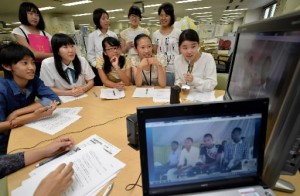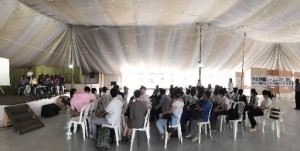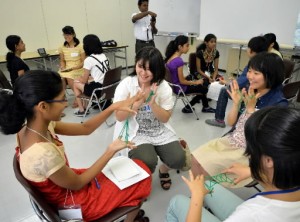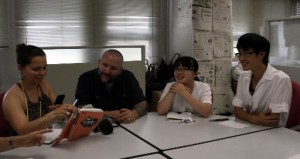Junior writers share wish for peace with people from overseas, deepen mutual understanding
Aug. 29, 2014
In August, the Chugoku Shimbun’s junior writers, who write articles and pursue other activities on the theme of peace, exchanged views with secondary school students from Rwanda and India, and with middle school teachers from the United States. These exchanges took place via teleconferencing over the Internet and through in-person meetings. The participants learned from each other, sharing what happened on August 6 in Hiroshima, 69 years ago, and the history, culture, and tragedies that have shaped their own nations. For the junior writers, the summer break was a time to reflect on peace.
Junior writers use the Internet to connect with high school students in Rwanda
by Yuji Yamamoto, Staff Writer
Through a video chat, junior writers in Hiroshima learned about the time of genocide that took place in Rwanda, and the participants from Kigali, the capital of that nation, learned about the atomic bombing. Eleven junior writers exchanged views with Rwandan high school students and with a member of the Japan Overseas Cooperation Volunteers (JOCV), who has been dispatched to Rwanda from Hiroshima, and discussed ways to advance the cause of peace.
The exchange was organized in conjunction with an A-bomb exhibition held in Kigali. About 60 people gathered at the venue in Kigali to take part in the exchange. One of them, Nkuriyingoma Ivan, 17, a fifth-year student at a secondary school called Grope Scolaire Gahini, talked about his impressions of the A-bomb exhibition and what he had learned about the atomic bombing. “Only survivors can tell us what happened in the past and teach us how we should live,” he said. “I want the leaders of the world to develop our world through education, not by building up military forces.”
When the junior writers asked him if he had known about the atomic bombing of Hiroshima, he said he had learned about the history behind the attack and the harm caused by the bomb’s radiation at school.
With regard to Rwanda’s past, the junior writers asked if there is still conflict among the different ethnic groups there. The students in Rwanda responded that there is no conflict now and that people have joined hands to create a peaceful country. Although challenges still remain, they stressed how efforts are being made to realize reconciliation through dialogue.
Nozomi Koyama, 30, a JOCV member dispatched to Rwanda from Fuchu-cho, Hiroshima Prefecture, described how the local people are reacting to the A-bomb exhibition. “The visitors to the exhibition are finding kinship with the survivors,” she said. “Many people died in the atomic bombing and in the genocide, and although the survivors are still suffering from the psychological trauma, they are making efforts to build peace.”
Shiori Niitani, 15, a junior writer who is a freshman in high school, said, “I didn’t know much about the genocide in Rwanda, so I want to study more about it. I’d like to convey Hiroshima’s experience of reconstruction to people overseas and contribute to building a better future.”
Keywords
Genocide in Rwanda
In the small African nation of Rwanda, the Hutus, the ethnic majority, killed members of the minority Tutsis after many years of antagonism. On April 6, 1994, an airplane carrying President Juvénal Habyarimana and others was shot down in the capital, Kigali. This sparked all-out bloodshed, in which government troops, consisting mainly of Hutus, and Hutu militias, reportedly massacred about 800,000 to one million Tutsis and moderate Hutus in about 100 days, until July of that year. Junior writers meet with students from India to convey “Hiroshima”
by Yumi Kanazaki, Staff Writer
Junior writers took part in an exchange with five female students from a middle school in Kerala, the southernmost state in India, who were invited to the Chugoku Shimbun building in Naka Ward. Through a cultural exchange, the Japanese students sought to have the students from India understand the wish for peace by children in Hiroshima.
James Joseph, 57, head of a citizens’ group called the India Chai Club Hiroshima and a resident of Kaita-cho, Hiroshima Prefecture, served as a bridge to connect the students from India with the junior writers. Mr. Joseph is making efforts to convey the atomic bombing of Hiroshima to the people of India, his mother country, and he has held an A-bomb exhibition at the middle school which the five students attend. He also helped coordinate their visit to Hiroshima so they could attend the Peace Memorial Ceremony on August 6.
Nine junior writers were present at the exchange and shared the series of articles written by the group of young journalists entitled “Survivors’ Stories,” in which they write about their interviews with A-bomb survivors and their impressions of those interviews. Chiaki Yamada, 14, a third-year junior high school student, said in English that she would like to continue writing articles on various peace-related activities to promote peace.
To overcome the language barrier, the junior writers showed the students from India how to fold paper cranes and how to play traditional Japanese games. The Indian students spontaneously demonstrated some folk dances, which enlivened the gathering.
Hiromi Ueoka, 13, a second-year junior high school student, said, “I think, as a start, that it’s important to take an interest in each other’s culture. Starting today, I’d like to study more about India.” Sivakami Nair, 15, said, “The junior writers are trying to create a better, peaceful world through their work. I learned that young people have power.”
Junior writers exchange views with middle school teachers from New York
by Rie Nii, Staff Writer
Junior writers from the Chugoku Shimbun met middle school teachers from New York and discussed how World War II is taught in schools. They explored differences between Japan and the United States, and decided to promote exchanges between the junior writers and students in New York.
Amber Malone, 38, a history teacher, and her husband Gary Malone, 40, an English teacher, visited Hiroshima around the anniversary of the atomic bombing on August 6. Four junior writers, from the eighth to the eleventh grade, told the two teachers their own experiences such as folding one thousand paper cranes on August 6 in elementary school, taking part in peace gatherings to listen to music played on an A-bombed piano, and studying in junior high school about the history of the aggression toward other Asian nations by the former Japanese military. The students also showed the American teachers their school textbooks.
Mr. and Mrs. Malone said that, in the United States, students learn about Hitler and the Holocaust in detail when they study World War II, but not much about the atomic bombings, other than that the atomic bombs were developed and used to end the war. They added that there are no formal peace education lessons.
Amber Malone said, “I met a survivor of the atomic bombing. Her story was so shocking. I recorded her testimony and I’d like to show it to my students. It would be wonderful if the junior writers and our students can take part in an exchange.” Arata Kono, 17, a high school sophomore, said, “I was eager to learn about peace education in other countries. It was interesting to hear from the teachers and I look forward to communicating with their students.”











